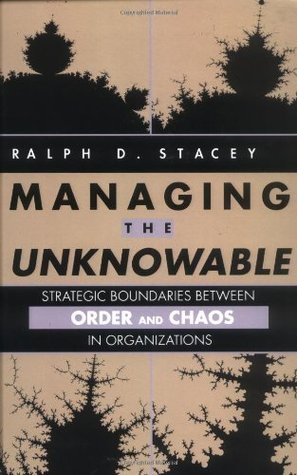What do you think?
Rate this book


239 pages, Hardcover
First published September 8, 1992
I've endured many hours of painful meetings in which people sit around and wordsmith vision statements ("Or, wait--isn't that actually a mission statement?" "Um, could we go over the difference between 'vision statements' and 'mission statements' again?" Ack. Time to open the laptop and sweep some mines...), or come up with long-range, basically impossible, goals and then try to make them fit into RBM charts (with circles and arrows and a paragraph on the back explaining what each one was, as Arlo would say). In all of those strategy meetings, we rarely get beyond a certain point, and what I now see is that it isn't possible to get beyond that point. I wonder if subconsciously we all realized that we actually need the chaos, the developing of strategy based on how we respond to short-term, day-to-day opportunities. Stacey says "that it is impossible to form a useful picture of a future state for a creative business system; that it is harmful to focus on single motivators to drive behavior when times are turbulent; and that it is impossible to install a business philosophy from scratch and highly dangerous to persuade all in a business to agree on a single philosophy. Instead, people in creative organizations are driven by many challenges arising in the present; they question the existing philosophy and even destroy aspects of it to make way for the new" (126). Amen.
Another frustration I've had with my organization is its sometimes obsessive desire that "every voice must be heard" in any decision-making process. Thus we sometimes have a roomful of people who really don't know anything about the topic at hand, but they're required to vote on the direction we take, and their votes count the same as the people who really do know about the topic. Stacey says:
[L]arge numbers of people can concern themselves with just about any issue, which they can raise at just about any decision-making forum. Decision-making forums then take the form of a "garbage can" into which issues, problems, and solutions tend to be thrown in a somewhat haphazard manner. Added to this, the participation of people in such forums tends to be fluid, with different people attending at different times because there are few rules requiring regular attendance. What issues are attended to and how they are resolved depends upon which group members are present, how interested they are in the issue, what other issues are attracting their attention, and what other work pressures are distracting them. In these circumstances, decisions emerge almost by chance. . . . [S]tudies have shown that widening participation and empowering people by no means guarantees that organizational learning will improve. (174-5)Wow. It's like he's been observing our organization for the past few years.
It's refreshing to read a book that, in essence, seems to say, "Hey! You were right to feel that all of this was nonsense!" What I wonder now is why this book, from 1992, is still so right about the way we're doing things now, over 20 years later. Why is this the first time I've read this perspective about the benefits of chaos? I hope that others have developed Stacey's themes, and that I've just somehow missed them till now. The writing style of this book is not the most exhilarating, but the content was extremely valuable, and I may well return to it again.